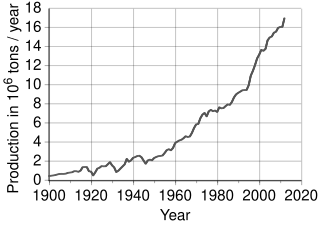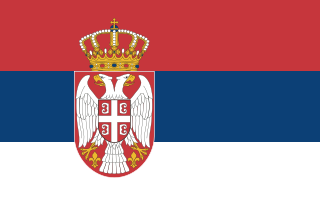
Chuquicamata, or "Chuqui" as it is more familiarly known, is by excavated volume the largest open pit copper mine in the world, located in the north of Chile, just outside Calama at 2,850 m (9,350 ft) above sea level, 215 km (134 mi) northeast of Antofagasta and 1,240 km (770 mi) north of the capital, Santiago. Flotation and smelting facilities were installed in 1952, and expansion of the refining facilities in 1968 made 500,000 ton annual copper production possible in the late 1970s. Previously part of Anaconda Copper, the mine is now owned and operated by Codelco, a Chilean state enterprise, since the Chilean nationalization of copper in the late 1960s and early 1970s. Its depth of 850 metres (2,790 ft) makes it the second deepest open-pit mine in the world.

Porphyry copper deposits are copper orebodies that are formed from hydrothermal fluids that originate from a voluminous magma chamber several kilometers below the deposit itself. Predating or associated with those fluids are vertical dikes of porphyritic intrusive rocks from which this deposit type derives its name. In later stages, circulating meteoric fluids may interact with the magmatic fluids. Successive envelopes of hydrothermal alteration typically enclose a core of disseminated ore minerals in often stockwork-forming hairline fractures and veins. Because of their large volume, porphyry orebodies can be economic from copper concentrations as low as 0.15% copper and can have economic amounts of by-products such as molybdenum, silver and gold. In some mines, those metals are the main product.

The Sungun copper mine is located in Varzaqan county, East Azarbaijan, Iran, 75 km north west of the provincial town of Ahar. It is the most important geologic and industrial feature in the area and is the largest open-cast copper mine in Iran and is in the primary stages of extraction.

Peak copper is the point in time at which the maximum global copper production rate is reached. Since copper is a finite resource, at some point in the future new production from mining will diminish, and at some earlier time production will reach a maximum. When this will occur is a matter of dispute. Unlike fossil fuels, copper is scrapped and reused and it has been estimated that at least 80% of all copper ever mined is still available. Copper is among the most important industrial metals, valued for its heat and electrical conductivities and malleability. Copper is used in electrical power cables, data cables, electrical equipment, cooling and refrigeration tubing, heat exchangers, brass casing small arms ammunition, water pipes, and jewellery.

Zijin Bor Copper d.o.o. Bor is a copper mining and smelting complex located in Bor, Serbia.

The Roșia Poieni copper mine is a large open pit copper mine in the centre of Romania, 90 km northwest of Alba Iulia and 484 km north of the capital, Bucharest. Geographically the mine is located in the Apuseni Mountains, 7 km (4.3 mi) south of the Arieş River in Lupșa commune. The access to the site is made through a south-west industrial haul road from Cornii Valley that crosses the National Road no. 74 Alba-Iulia – Zlatna – Abrud when entering Abrud and through a north industrial haul road from Musca Valley that crosses the National Road no. 75 Campeni – Turda in Musca village, Lupșa commune.

The Batu Hijau mine is an open pit copper-gold mine operated by PT. Amman Mineral Nusa Tenggara. The mine is located 1,530 kilometres (950 mi) east of the Indonesian capital Jakarta on Sumbawa, in southern Taliwang Regency, an island in West Nusa Tenggara. The mine is the result of a ten-year exploration and construction program based on a 1999 discovery of the porphyry copper deposit. Production began in 2000.

Helvetia is a populated place in Pima County, Arizona, that was settled in 1891 and abandoned in the early 1920s. Helvetia is an ancient name for Switzerland.

The Reko Diq mine is located near Reko Diq town in Chagai District, Baluchistan, Pakistan. It is a large copper mine located in the west of Pakistan in Balochistan. Reko Diq represents one of the largest copper reserve in Pakistan and in the world having estimated reserves of 5.9 billion tonnes of ore grading 0.41% copper. The mine also has gold reserves amounting to 41.5 million oz.

The Robinson Mine is a porphyry copper deposit located in the Robinson Mining District, adjacent to Ruth in White Pine County, Nevada. In early 2012 the mine was acquired by Polish KGHM Polska Miedz.

Escondida is a copper mine in the Atacama Desert in Antofagasta Region, Chile. The Escondida deposit is one of a cluster of porphyry coppers in an elongated area about 18 km north-south and 3 km east-west and is associated with the 600 km long West Fissure system, which is in turn associated with most of the major Chilean porphyry deposits. A barren, leached cap, in places up to 300 metres thick, overlies a thick zone of high grade secondary supergene mineralisation of the main orebody, largely chalcocite and covellite, which in turn overlies the unaltered primary mineralisation of chalcopyrite, bornite and pyrite.
The Los Pelambres mine is a large copper mine located in the north-central of Chile in Coquimbo Region. Los Pelambres is one of the largest copper reserves in the world, having estimated reserves of 4.9 billion tonnes of ore grading 0.65% copper.
The Majdanpek mine is a large copper mine located in the east of Serbia in Bor District. Majdanpek represents one of the largest copper reserve in Serbia and in the world having estimated reserves of 619.5 million tonnes of ore grading 0.33% copper. The mine also has gold reserves amounting to 7.68 million oz and silver reserves of 56 million oz.
The Surdulica mine is one of the largest molybdenum mines in Serbia. The mine is located near Surdulica in south Serbia in Pčinja District. The Surdulica mine has reserves amounting to 125 million tonnes of molybdenum ore grading 0.05% molybdenum thus resulting 62,500 tonnes of molybdenum.
The Bor mine is a large copper mine located in the east of Serbia in Bor District. Bor is one of the largest copper reserves in Serbia and in the world, having estimated reserves of 200 million tonnes of ore grading 1.5% copper.
The Dumitru Potok mine is a large copper mine located in the east of Serbia in Bor District. Dumitru Potok represents one of the largest copper reserve in Serbia and in the world having estimated reserves of 790 million tonnes of ore grading 0.2% copper.

The Quinchía mine is a gold mine in Colombia. The mine is located in Quinchía, Risaralda. The mine has estimated reserves of 390,000 ounces (11 t) of gold and 817,000 ounces (23.2 t) of silver. In 2016, Quinchía produced 73,475.73 kilograms (2,591,780 oz) of gold, and 10,587.99 kilograms (373,480 oz) of silver.
The Quellaveco mine is a large copper mine project located in the south of Peru in the Moquegua Region. It is undergoing government environment approvals for its Environmental Impact Assessment. The last EIA modification was submitted in 2014. The Quellaveco mining property is majority–owned by Anglo American. Quellaveco represents one of the largest copper reserves in Peru and in the world, having estimated reserves of 1.1 billion tonnes of ore grading 0.55% copper. The planned development of the mine estimates a processing capacity of 85000 metric tonnes per day. Fluor Corporation has been assigned as the EPCM contractor for this project.
The Cuajone mine is a large copper mine located in the south of Peru in Moquegua Region. Cuajone represents one of the largest copper reserve in Peru and in the world having estimated reserves of 1.6 billion tonnes of ore grading 0.57% copper.

Molybdenum mining in the United States produced 65,500 metric tons of molybdenum in 2014, worth US$1.8 billion. The US was the world’s second-largest molybdenum producer, after China, and provided 25% of the world’s supply of molybdenum.
















